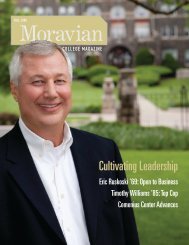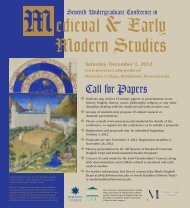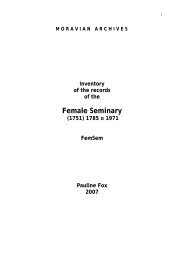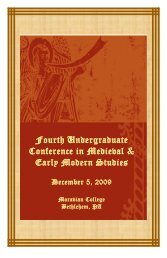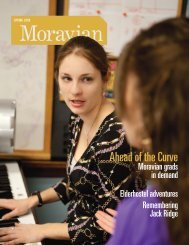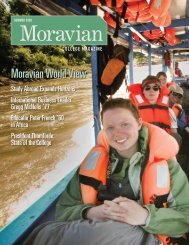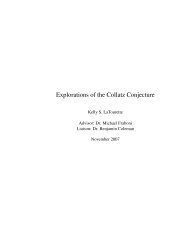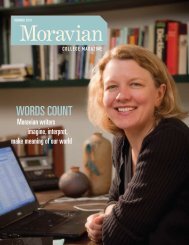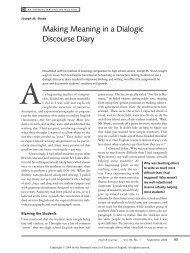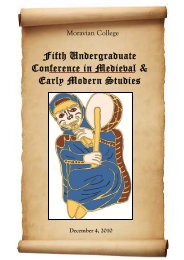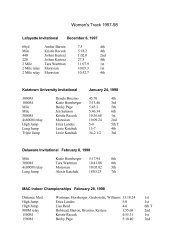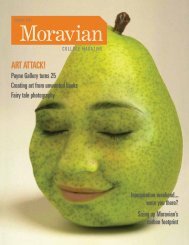Big Man on Campus - Moravian College
Big Man on Campus - Moravian College
Big Man on Campus - Moravian College
Create successful ePaper yourself
Turn your PDF publications into a flip-book with our unique Google optimized e-Paper software.
photo by John Kish iV<br />
out&about<br />
Dance with Your Ears<br />
HAPPENING . . .<br />
February 1 – March 11<br />
Edouard Matthiew Pannetier<br />
PAyNE GAllEry • An exhibit of never-<br />
before- displayed drawings and paintings by<br />
the French-Cambodian surrealist, known as<br />
“Peccadet” to artist friends like Picasso.<br />
February 21<br />
Lawrence Brownlee, tenor<br />
Foy CoNCErt HAll • A remarkable<br />
evening of music with <strong>on</strong>e<br />
of today’s leading bel canto<br />
tenors.<br />
A Kulu Mele<br />
dancer teaches<br />
<strong>Moravian</strong>s the<br />
right moves.<br />
Good dancing starts with good listening, says Dorothy Wilkie, artistic<br />
director and choreographer of Kulu Mele African American Dance<br />
Ensemble. “Beginners have to learn to listen to the drum,” she explains.<br />
“Each rhythm has its own call, and that tells you when to start, change,<br />
and stop.” The ensemble, whose name means “voice of our ancestors,”<br />
visited the <strong>Moravian</strong> campus in December 2006 for a program of dances<br />
and rhythms from Africa, Brazil, Haiti, Cuba, and the U.S. Students and<br />
faculty members had an opportunity to move to the beat of African<br />
drumming during a pre-c<strong>on</strong>cert workshop. The steps may be different,<br />
but music and dance play similar roles in African and American culture,<br />
says Wilkie. “They play music for many reas<strong>on</strong>s—for the birth of a baby,<br />
for a celebrati<strong>on</strong>, for a naming cerem<strong>on</strong>y. Here we have music at baby<br />
showers, parties, and weddings.”<br />
March 15 – April 15<br />
The Design of Dissent<br />
PAyNE GAllEry • renowned graphic designer<br />
Milt<strong>on</strong> Glaser and illustrator Mirko Ilic present<br />
an exhibit of socially- and politically-driven<br />
graphics.<br />
Medieval Is Good for You<br />
How did the Reformati<strong>on</strong> alter the represen-<br />
tati<strong>on</strong> of women? What narrative strate-<br />
gies did Chaucer use in the Canterbury<br />
Tales? How were dreams interpreted in the<br />
Carolingian period? <str<strong>on</strong>g>Man</str<strong>on</strong>g>y such questi<strong>on</strong>s<br />
were answered—or at least thoroughly dis-<br />
cussed—at the Undergraduate C<strong>on</strong>ference in<br />
Medieval and Early Modern Studies, hosted<br />
by <strong>Moravian</strong> <strong>College</strong> <strong>on</strong> Saturday, December<br />
2, 2006. The c<strong>on</strong>ference featured 28 research<br />
presentati<strong>on</strong>s by students from <strong>Moravian</strong><br />
and several other colleges and universities.<br />
The 220 attendees, representing 25 schools,<br />
also witnessed performances and dem<strong>on</strong>-<br />
strati<strong>on</strong>s (including two <strong>Moravian</strong> music<br />
majors who c<strong>on</strong>structed a 15th-century<br />
trumpet). Other events included a plenary<br />
speech by Arthurian literature specialist Kel-<br />
ley Wickham-Crowley, associate professor of<br />
English at Georgetown University in Wash-<br />
ingt<strong>on</strong>, D.C., and a performance of Sephardic<br />
Blow your own horn: <strong>Moravian</strong> students Christopher<br />
A. Lucca ’09 and Sean Mas<strong>on</strong> ’08 dem<strong>on</strong>strate the<br />
15-th century trumpet they created for <strong>Moravian</strong>’s<br />
C<strong>on</strong>ference in Medieval and Early Modern Studies.<br />
music by members of the Baltimore C<strong>on</strong>sort<br />
and Quartetto Brio.<br />
Vespers in Televisi<strong>on</strong>land<br />
Taking a close look at these periods<br />
in history does more than solve historical<br />
enigmas or offer glimpses into a byg<strong>on</strong>e<br />
mindset, says John Black, assistant profes-<br />
sor of English at <strong>Moravian</strong> and <strong>on</strong>e of the<br />
c<strong>on</strong>ference organizers (with Sandy Bardsley,<br />
assistant professor of history). It teaches<br />
you to think outside your own particular<br />
box. “One of the main appeals of this field<br />
is its interdisciplinary aspect,” says Black.<br />
“You can’t approach it with blinders <strong>on</strong>.”<br />
While it’s possible to view the Middle Ages<br />
strictly from, say, an art history perspective,<br />
real understanding <strong>on</strong>ly comes from bring-<br />
ing together informati<strong>on</strong> from history, art,<br />
literature, religi<strong>on</strong>, music, and other fields.<br />
And professors or students who learn to do<br />
that will find it’s a skill that’s sorely needed<br />
in today’s world. “Our modern worldview is<br />
utterly fragmented,” Black says. “We’re so<br />
drawn and torn and pushed and shoved and<br />
rushed and frantic that there’s hardly time<br />
for synthesis, for seeing how you or any<strong>on</strong>e<br />
else fits into the big picture.”<br />
A <strong>Moravian</strong> <strong>College</strong> traditi<strong>on</strong> gained its widest audience yet when thirteen NBC-tV affiliates around the<br />
country broadcast The Music of Vespers from Bethlehem . . . the Christmas City <strong>on</strong> Christmas day 2006.<br />
the program featured a repertoire of sacred and spiritual s<strong>on</strong>gs from a wide variety of cultures performed<br />
by the <strong>Moravian</strong> Choir, under the directi<strong>on</strong> of Paula ring Zerkle, and by the Women’s Chorus, under the<br />
directi<strong>on</strong> of Eduardo Azzati. Selecti<strong>on</strong>s included an Australian aboriginal chant, the words of John Milt<strong>on</strong><br />
and Walt Whitman, and music composed by <strong>Moravian</strong> students. Also featured were Vespers standards<br />
like the hymns Morning Star and Jesus, Call Thou Me (Jesu, rufe mich). While nearly 6,000 members of<br />
the <strong>Moravian</strong> <strong>College</strong> community attend the Vespers services every year in Bethlehem, the broadcasts<br />
allowed viewers as far away as Michigan and oklahoma to enjoy them. or, in the case of former Choir<br />
soloist Susan Mcleish ’75, to enjoy them again. “Imagine my surprise,” says Mcleish, who lives outside<br />
of Atlanta, Georgia, “when I arose at 5:00 a.m. to make <strong>Moravian</strong> sugar cake, turned <strong>on</strong> the tV in hopes of<br />
finding something holidayish, and found the <strong>Moravian</strong> Vespers being broadcast!”<br />
MORAVIAN COLLEGE MAGAZINE WINTER 2007 WINTER 2007 MORAVIAN COLLEGE MAGAZINE<br />
photo by John Kish iV



